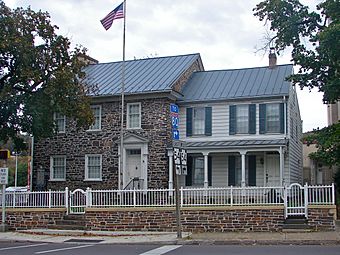General William Montgomery House facts for kids
|
Gen. William Montgomery House
|
|
 |
|
| Location | 1 and 3 Bloom St., Danville, Pennsylvania |
|---|---|
| Area | 0.4 acres (0.16 ha) |
| Built | 1777 |
| NRHP reference No. | 79002305 |
Quick facts for kids Significant dates |
|
| Added to NRHP | August 09, 1979 |
The Gen. William Montgomery House is a very old and important building in Danville, Pennsylvania. It is located in Montour County, Pennsylvania. This historic house was once the home of General William Montgomery, who lived from 1736 to 1816. He was a very important person because he helped create the town of Danville!
The house itself is made of stone and has two and a half stories. Part of the house is even older, built around 1777. This older section is made of logs and wood.
In 1979, the house was added to the National Register of Historic Places. This means it is a special place recognized for its history.
Contents
Discovering the Montgomery House
The Montgomery House is a fascinating place to visit. It shows us what homes looked like a long time ago. The main part of the house is made of strong stone. It has a special roof shape called a gable roof.
A Look at the House's History
The oldest part of the house is a log and wood structure. It was built around 1777. This was a very long time ago, even before the United States was fully formed! Later, the larger stone part was added.
Who Was General William Montgomery?
General William Montgomery was born in 1736. He was a soldier and a leader. He is most famous for being the person who developed Danville. This means he helped plan and build the town. He was a very important figure in the early history of Pennsylvania. He lived in this house until he passed away in 1816.
Visiting the Historic House Today
Today, the Montgomery House is owned by the Montour County Historical Society. They work hard to keep the house in good condition. They want people to learn about its history.
You can visit the house for tours. It is usually open on Sunday afternoons during certain seasons. It's a great way to step back in time and see how people lived hundreds of years ago.
See also



